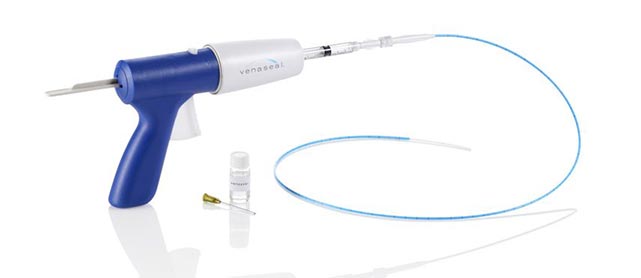VenaSeal™ Closure System
Treat
Superficial venous reflux disease treatment aims to reduce or stop the backward flow of blood. Treating the diseased veinn improves overall blood flow and relieves symptoms. For some patients, compression stockings alone may improve blood flow. For other patients, closing or removing the diseased vein may be necessary to improve blood flow. Closing or removing the diseased vein directs blood to nearby healthy veins. Your doctor can help you decide which treatment option is best for you.

VenaSeal™ Closure System
The VenaSeal system improves blood flow by sealing-or closing-the diseased vein. The system delivers a small amount of a specially formulated medical adhesive to the diseased vein. the adhesive seats the vein and blood is rerouted through nearby healthy veins.
F.A.Q.
What can I expect of the VenaSeal procedure?
Before the Procedure:
You will have an ultrasound imaging exm of the leg that is to be treated. This exam is important for assessing the diseased superfical vein and planning the procedure.
During the Procedure:
Your doctor can discuss the procedure with you. A brief summary of what to expect is below:
- You may feel some minor pain or stinging with a needle stick to numb the site where the doctor will access your vein.
- Once the area is numb, your doctor will insert the catheter (i.e., a small hollow tube) into your leg. You may feel some pressure from the placement of the catheter.
- The catheter will be placed in specific areas along the diseased vein to deliver small amounts of the medical adhesive. You may feel some mild sensation of pulling or tugging. Ultrasound will be used during the procedure to guide and position the catheter.
- After treatment, the catheter is removed and a bandage placed over the puncture site.
After the Procedure
You will be taken to the recovery area to rest. Your doctor will discuss with you what observations will be performed following treatment.
When will my symptoms improve?
Symptoms are caused by the diseased superficial vein. Thus, symptoms may improve as soon as the diseased vein is closed.
When can I return to normal activity?
The VenaSeal procedure is designed to reduce recovery time. Many patients return to normal activity immediately after the procedure. Your doctor can help you determine when you can return to normal activity.
Is the VenaSeal procedure painful?
Most patients feel little, if any, pain during the outpatient procedure.
Is there brusing after the VenaSeal procedure?
Only a very small amount of VenaSeal adhesive is used to close the vein. Your body will naturally absorb the adhesive over time.
What happens to the VenaSeal adhesive?
asdf
How does the VenaSeal procedure differ from thermal energy procedures?
The VenaSeal procedure uses an adhesive to close the superficial vein. Thermal energy procedures use heat to close the vein. The intense heat requires a large volume of numbing medicine, which is injected through many needle sticks. the injections may cause pain and bruising after the procedure.
Is the VenaSeal procedure covered by insurance?
As with any procedure, insurance coverage amy vary. For more information, please contact your insurance provider.
The VenaSeal™ Procedure may not be right for everyone
Your doctor can help you decide if the VenaSeal procedure is right for you. The VenaSeal procedure is contraindicated for individuals with any of the following conditions.
- Thrombophiebitis migrans (i.e., inflammation of a vein caused by a slow moving blood clot)
- Acute superficial thrombophiebitis (i.e., inflammation of a vein caused by a blood clot)
- Previous hypersenitivity reactions to the VenaSeal adhesive or cyanoarylates
- Acute sepsis (i.e., whole-body inflammation caused by an immune response to an infection)
Potential Risks
The VenaSeal procedure is minimally invasive and catheter-based. As such, it may involve the following risks. your doctor can help you understand these risks.
- Allergic reaction to the VenaSeal adhesive
- Arteriovenous fistula (i.e., an abnormal connection between an artery and a vein)
- Bleeding from the access site
- Deep vein thrombosis (i.e., blood clot in the deep vein system)
- Edema (i.e., swelling) in the treated leg
- Hematoma (i.e., the collection of blood outside of a vessel)
- Infection at the access site
- Neurological deficits include stroke and death
- Non-specific mild inflammation of the cutaneous and subcutaneous tissue
- Pain
- Paresthesia (i.e., a feeling of tingling, pricking, numbness or burning)
- Phlebitis (i.e., blockage of an artery in the lungs)
- Pulmonary embolism (i.e., blockage of an artery in the lungs)
- Urticaria (i.e., hives) or ulceration may occure at the site of injection
- Vascular rupture andperforation
- Visible scarring


